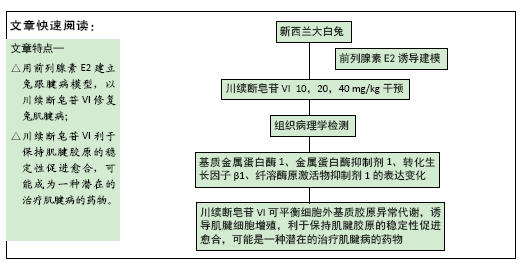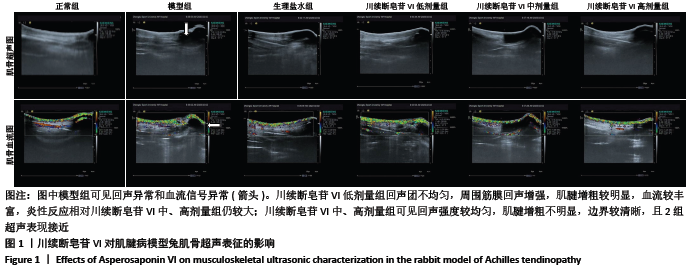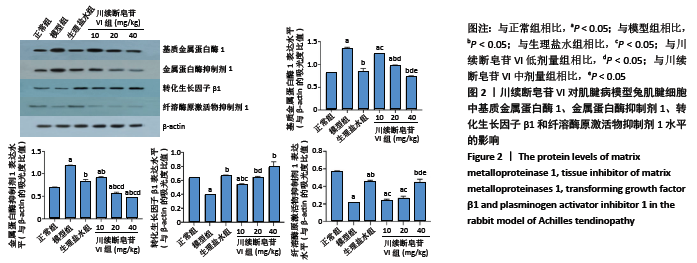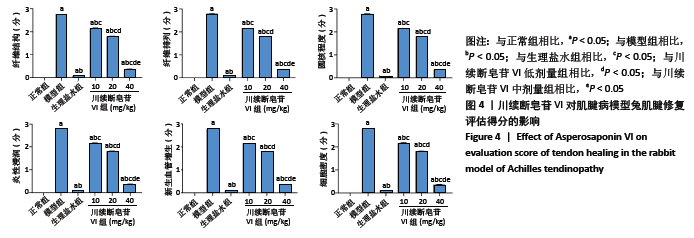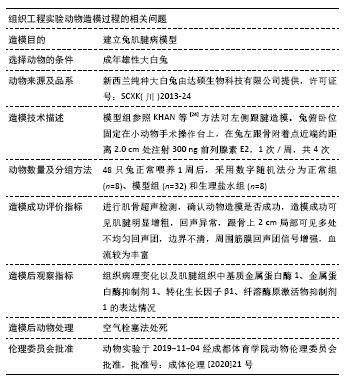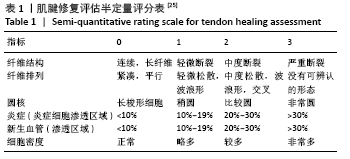[1] NOURISSAT G, BERENBAUM F, DUPREZ D. Tendon injury: from biology to tendon repair. Nat Rev Rheumatol. 2015;11(4):223-233.
[2] RADOVANOVIĆ G, WOLFARTH B, LEGERLOTZ K. Interleukin‐6 levels drop after a 12 week long physiotherapeutic intervention in patients with Achilles tendinopathy—a pilot study. Transl Sports Med. 2019;2: 233-239.
[3] WANG Y, HE G, GUO Y, et al. Exosomes from tendon stem cells promote injury tendon healing through balancing synthesis and degradation of the tendon extracellular matrix. J Cell Mol Med. 2019;23(8):5475-5485.
[4] KHAN MR, SMITH RK, DAVID F, et al. Evaluation of the Effects of Synovial Multipotent Cells on Deep Digital Flexor Tendon Repair in a Large Animal Model of Intra-Synovial Tendinopathy. J Orthop Res. 2020; 38(1):128-138.
[5] WANG Y, HE G, TANG H, et al. Aspirin inhibits inflammation and scar formation in the injury tendon healing through regulating JNK/STAT-3 signalling pathway. Cell Prolif. 2019;52(4):e12650.
[6] ALVES C, MENDES D, MARQUES FB. Fluoroquinolones and the risk of tendon injury: a systematic review and meta-analysis. Eur J Clin Pharmacol. 2019;75(10):1431-1443.
[7] TEIXEIRA PAG, JAQUET P, BAKOUR O, et al. CT arthrography of the intra-articular long head of biceps tendon: Diagnostic performance outside the labral-bicipital complex. Diagn Interv Imaging. 2019;100(7-8): 437-444.
[8] ZAMZAM M, EL YASAKI A, EL GARABAWY N, et al. Shockwave therapy versus local steroid injection in chronic supraspinatus tendinopathy. Egypt Rheumatol Rehabil. 2019;46:141-147.
[9] DAN MJ, WALSH WR, CROSS MJ, et al. Treatment of patella tendinopathy by distalising tibial tubercle osteotomy. BMJ Case Rep. 2019;12(7):e229209.
[10] BAAR K. Stress Relaxation and Targeted Nutrition to Treat Patellar Tendinopathy. Int J Sport Nutr Exerc Metab. 2019;29(4):453-457.
[11] NIE G, WEN X, LIANG X, et al. Additional evidence supports association of common genetic variants in MMP3 and TIMP2 with increased risk of chronic Achilles tendinopathy susceptibility. J Sci Med Sport. 2019;22(10):1074-1078.
[12] LEE SY, KIM W, LIM C, et al. Treatment of Lateral Epicondylosis by Using Allogeneic Adipose-Derived Mesenchymal Stem Cells: A Pilot Study. Stem Cells. 2015;33(10):2995-3005.
[13] RUI YF, LUI PP, LI G, et al. Isolation and characterization of multipotent rat tendon-derived stem cells. Tissue Eng Part A. 2010;16(5):1549-1558.
[14] ARNSDORF EJ, TUMMALA P, JACOBS CR. Non-canonical Wnt signaling and N-cadherin related beta-catenin signaling play a role in mechanically induced osteogenic cell fate. PLoS One. 2009;4(4):e5388.
[15] GURTNER GC, WERNER S, BARRANDON Y, et al. Wound repair and regeneration. Nature. 2008;453(7193):314-321.
[16] LIU ZG, ZHANG R, LI C, et al. The osteoprotective effect of Radix Dipsaci extract in ovariectomized rats. J Ethnopharmacol. 2009;123(1):74-81.
[17] JUNG HW, JUNG JK, SON KH, et al. Inhibitory effects of the root extract of Dipsacus asperoides C.Y. Cheng et al T.M.Ai on collagen-induced arthritis in mice. J Ethnopharmacol. 2012;139(1):98-103.
[18] Wong RW, Rabie AB, Hägg EU. The effect of crude extract from Radix Dipsaci on bone in mice. Phytother Res. 2007;21(6):596-598.
[19] HUNG TM, NA M, THUONG PT, et al. Antioxidant activity of caffeoyl quinic acid derivatives from the roots of Dipsacus asper Wall. J Ethnopharmacol. 2006;108(2):188-192.
[20] KE K, LI Q, YANG X, et al. Asperosaponin VI promotes bone marrow stromal cell osteogenic differentiation through the PI3K/AKT signaling pathway in an osteoporosis model. Sci Rep. 2016;6:35233.
[21] LOISELLE AE, YUKATA K, GEARY MB, et al. Development of antisense oligonucleotide (ASO) technology against Tgf-β signaling to prevent scarring during flexor tendon repair. J Orthop Res. 2015;33(6):859-866.
[22] QIN W, LIN ZM, DENG R, et al. p38a MAPK is involved in BMP-2-induced odontoblastic differentiation of human dental pulp cells. Int Endod J. 2012;45(3):224-233.
[23] 秦川.实验动物学[M].北京:人民卫生出版社,2010.
[24] KHAN MH, LI Z, WANG JH. Repeated exposure of tendon to prostaglandin-E2 leads to localized tendon degeneration. Clin J Sport Med. 2005;15(1):27-33.
[25] 陈磊.富血小板血浆诱导肌键干细胞增殖分化对肌键微损伤修复的作用[D].重庆:第三军医大学,2012.
[26] TSUZAKI M, GUYTON G, GARRETT W, et al. IL-1 beta induces COX2, MMP-1, -3 and -13, ADAMTS-4, IL-1 beta and IL-6 in human tendon cells. J Orthop Res. 2003;21(2):256-264.
[27] 史晓伟,龙丽娟,沈勇伟,等,末端病大鼠跟腱病超微结构、胶原、MMP-1及TIMP1的研究[J].中国运动医学杂志,2014,33(9):902-906.
[28] YANG S, ZHANG W, XUAN LL, et al. Akebia Saponin D inhibits the formation of atherosclerosis in ApoE-/- mice by attenuating oxidative stress-induced apoptosis in endothelial cells. Atherosclerosis. 2019; 285:23-30.
[29] TSUJIMOTO Y. Cell death regulation by the Bcl-2 protein family in the mitochondria. J Cell Physiol. 2003;195(2):158-167.
[30] WANG CG, LOU YT, TONG MJ, et al. Asperosaponin VI promotes angiogenesis and accelerates wound healing in rats via up-regulating HIF-1α/VEGF signaling. Acta Pharmacol Sin. 2018;39(3):393-404.
[31] KE K, LI Q, YANG X, et al. Asperosaponin VI promotes bone marrow stromal cell osteogenic differentiation through the PI3K/AKT signaling pathway in an osteoporosis model. Sci Rep. 2016;6:35233.
[32] NIU Y, LI Y, HUANG H, et al. Asperosaponin VI, a saponin component from Dipsacus asper wall, induces osteoblast differentiation through bone morphogenetic protein-2/p38 and extracellular signal-regulated kinase 1/2 pathway. Phytother Res. 2011;25(11):1700-1706.
[33] BI F, SHI Z, JIANG S, et al. Intermittently administered parathyroid hormone [1-34] promotes tendon-bone healing in a rat model. Int J Mol Sci. 2014;15(10):17366-17379.
[34] PARK JY, PARK SD, KOH YJ, et al. Aqueous extract of Dipsacus asperoides suppresses lipopolysaccharide-stimulated inflammatory responses by inhibiting the ERK1/2 signaling pathway in RAW 264.7 macrophages. J Ethnopharmacol. 2019;231:253-261.
[35] MAJEWSKI M, PORTER RM, BETZ OB, et al. Improvement of tendon repair using muscle grafts transduced with TGF-β1 cDNA. Eur Cell Mater. 2012;23:94-102.
[36] OKAMOTO S, TOHYAMA H, KONDO E, et al. Ex vivo supplementation of TGF-beta1 enhances the fibrous tissue regeneration effect of synovium-derived fibroblast transplantation in a tendon defect: a biomechanical study. Knee Surg Sports Traumatol Arthrosc. 2008;16(3):333-339.
[37] YAMAZAKI S, YASUDA K, TOMITA F, et al. The effect of transforming growth factor-beta1 on intraosseous healing of flexor tendon autograft replacement of anterior cruciate ligament in dogs. Arthroscopy. 2005; 21(9):1034-1041.
[38] PREMDAS J, TANG JB, WARNER JP, et al. The presence of smooth muscle actin in fibroblasts in the torn human rotator cuff. J Orthop Res. 2001;19(2):221-228.
[39] 王尉,何恢绪,彭心昭,等.转化生长因子-β1对肌腱细胞DNA及胶原合成的影响[J].中华创伤杂志,2001,17(10):618-619.
[40] MICHEL K, ROTH S, TRAUTWEIN C, et al. Analysis of the expression pattern of the latent transforming growth factor beta binding protein isoforms in normal and diseased human liver reveals a new splice variant missing the proteinase-sensitive hinge region. Hepatology. 1998;27(6):1592-1599.
[41] 耿震,王震,周海洋.富血小板血浆对肌健愈合影响的实验研究[J].中国修复重建外科杂志,2011,25(3):344-348.
[42 ] 史晓伟,周学兰.TGF-β1多效性与肌腱修复研究进展[J].中国运动医学杂志,2016,35(6):588-591.
[43] FAVATA M, BEREDJIKLIAN PK, ZGONIS MH, et al. Regenerative properties of fetal sheep tendon are not adversely affected by transplantation into an adult environment. J Orthop Res. 2006;24(11):2124-2132.
[44] CHEN Q, LU H, YANG H. Chitosan inhibits fibroblasts growth in Achilles tendon via TGF-β1/Smad3 pathway by miR-29b. Int J Clin Exp Pathol. 2014;7(12):8462-8470.
[45] FU SC, WONG YP, CHEUK YC, et al. TGF-beta1 reverses the effects of matrix anchorage on the gene expression of decorin and procollagen type I in tendon fibroblasts. Clin Orthop Relat Res. 2005;(431):226-232.
[46] MAUVIEL A, CHUNG KY, AGARWAL A, et al. Cell-specific induction of distinct oncogenes of the Jun family is responsible for differential regulation of collagenase gene expression by transforming growth factor-beta in fibroblasts and keratinocytes. J Biol Chem. 1996;271(18): 10917-10923.
[47] MARTIN J, YUNG S, ROBSON RL, et al. Production and regulation of matrix metalloproteinases and their inhibitors by human peritoneal mesothelial cells. Perit Dial Int. 2000;20(5):524-533.
[48] MA C, CHEGINI N. Regulation of matrix metalloproteinases (MMPs) and their tissue inhibitors in human myometrial smooth muscle cells by TGF-beta1. Mol Hum Reprod. 1999;5(10):950-954.
[49] FARHAT YM, AL-MALIKI AA, CHEN T, et al. Gene expression analysis of the pleiotropic effects of TGF-β1 in an in vitro model of flexor tendon healing. PLoS One. 2012;7(12):e51411.
[50] FARHAT YM, AL-MALIKI AA, EASA A, et al. TGF-β1 Suppresses Plasmin and MMP Activity in Flexor Tendon Cells via PAI-1: Implications for Scarless Flexor Tendon Repair. J Cell Physiol. 2015;230(2):318-326.
[51] YANG Y, YANG S, CHEN M, et al. Compound Astragalus and Salvia miltiorrhiza Extract exerts anti-fibrosis by mediating TGF-beta/Smad signaling in myofibroblasts. J Ethnopharmacol. 2008;118(2):264-270.
[52] TUAN TL, WU H, HUANG EY, et al. Increased plasminogen activator inhibitor-1 in keloid fibroblasts may account for their elevated collagen accumulation in fibrin gel cultures. Am J Pathol. 2003;162(5): 1579-1589.
[53] TITAN AL, LONGAKER MT. A fine balance in tendon healing. Nat Cell Biol. 2019;21(12):1466-1467.
[54] SPIESZ EM, THORPE CT, CHAUDHRY S, et al. Tendon extracellular matrix damage, degradation and inflammation in response to in vitro overload exercise. J Orthop Res. 2015;33(6):889-897. |
